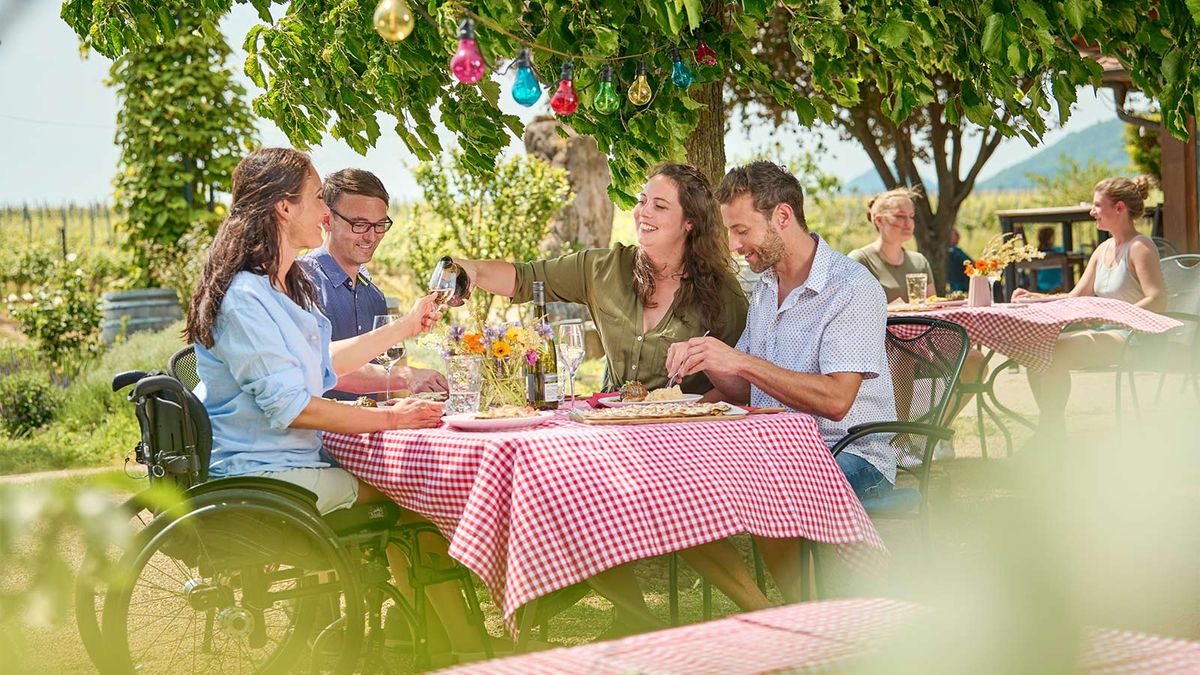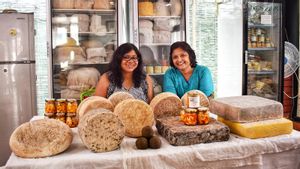“Do you like it?” my guide Peter Hiery asks me as I sip on a glass of trocken (dry) Riesling at Weingut Aloisiushof in the postcard-perfect village of Sankt Martin (St. Martin) in the Rhineland-Palatinate state of western Germany. The wine is fresh and juicy with notes of ripe apricot and peach, perhaps even a touch of mango. It’s also incredibly easy to drink; I quickly finish my tasting portion and ask for more. Peter seems pleased and he tells me that the wine contains grapes from his vineyard, which comes as no surprise. In a village of 1,850 people, St. Martin has no fewer than 40 wineries. So literally everyone is a winemaker!
Wine country
St. Martin is just one of the many pretty villages on the so-called German Wine Route. Established in 1935, this 85-km trail traverses Rhineland-Palatinate, Germany’s second-largest wine-growing region, running from Schweigen-Rechtenbach on the French border to Bockenheim in the north. The route was started with the idea of connecting all the vintners' villages to boost wine sales after a record harvest in 1934.
Start your wine discovery on either end of the route. The German Wine Gate, an imposing ceremonial sandstone gatehouse, in Schweigen-Rechtenbach is a good entry point if you’re coming in from the Alsace wine route in France. Alternatively, if you fly into Frankfurt, the northern starting point of Bockenheim is just 100 km south of the city.

The Palatinate region is blessed with a mild, Mediterranean climate, so you will find fruits like figs, lemons, and kiwis being cultivated here. In spring, the countryside is ablaze with pink and white almond blossoms. In autumn, the colourful foliage of Palatinate forests and vineyards is breathtaking; this is a great time to visit because there are many wine and harvest festivals along the route. From early- to mid-September, you can also taste Federweisser, a cloudy, still-fermenting, young wine that’s sweet and mildly sparkling — remember to stick to a glass or two as this unfiltered wine can affect your stomach!

But the pride and joy of the German Wine Route is the Riesling, and you will find it in different styles here — dry, semi-sweet, and sparkling. Other grape varieties include Müller-Thurgau, pinot blanc and pinot gris. A few wineries also produce red wines, but this is predominantly a white wine-producing region, although even a red wine lover like me found plenty to enjoy (and bring back home).
Scenic stops
The German Wine Route passes by quaint villages with half-timbered houses and old taverns, medieval castles, centuries-old abbeys, and miles upon miles of vineyards. Look out for the yellow signposts that say Deutsche Weinstrasse — the route is perfect for a road trip along with cycling, walking, and hiking excursions on the side. It is also incredibly accessible, providing barrier-free entry at many wineries, taverns, and castles.

Begin your wine journey in the north at the Haus der DeutschenWeinstrasse (House of the German Wine Route). Built to resemble a Roman fortification, the timber building houses a restaurant serving regional specialties and local wines. Then, proceed to the spa town of Bad Dürkheim, which is home to the world's biggest wine barrel with the capacity to hold 44 million gallons of wine. It has been converted into a multi-level restaurant where you can enjoy wine-tasting sessions and fine dining.

Every September (second and third weekends), the town hosts the world’s biggest wine festival called the “Wurstmarkt”. Apart from fine wines and local sausages, there’s live music, carnival rides, and even literature contests in Pfälzisch (the regional dialect). While you’re here, make time to visit Villa Rustica Weilberg, a partially reconstructed Roman-era manor house (the Romans introduced winemaking to the region more than 2,000 years ago). Make your way further south to Deidesheim, which has some of the world’s best vineyards for Riesling as well as seven Michelin-starred restaurants. Its historic Rathaus (town hall) holds an interesting wine museum.
High castle

Next stop, Hambach Castle, which is considered a symbol of German democracy, since the black, red, and gold tricoloured flag was first unfurled at the Hambacher Fest in 1832. The castle has been extensively renovated and contains a museum with multi-media exhibits as well as the original flag (all information is provided in German, so you will need a local guide).
The village of St. Martin is a short drive from the castle. Apart from Weingut Aloisiushof, I also recommend Herrengut St. Martin for a wine-tasting. The nearby restaurant at Hotel St. Martiner Castell is perfect for a hearty meal of local meat specialities paired with wine.

A 15-minute drive from St. Martin brings you to Castle Villa Ludwigshöhe, the former summer residence of Ludwig I of Bavaria. The Italian-style villa features intricate ceiling and wall paintings and offers a lovely view over the Palatinate Forest. Further along the route, just south of Landau, you will come upon the ruins of Landeck Castle, a former knight’s castle that dates to the early 1200s. From the castle, it’s another short drive (15 km) to Schweigen-Rechtenbach, and the end of the German Wine Route.
Note that the route is closed for vehicular traffic on the last Sunday of August (although it’s open for walkers, hikers, and cyclists).





